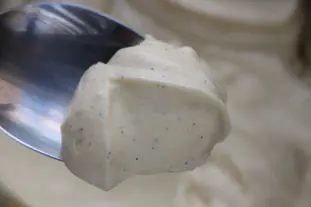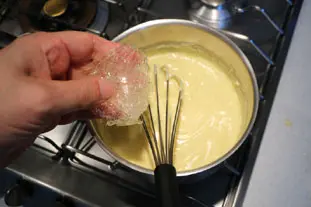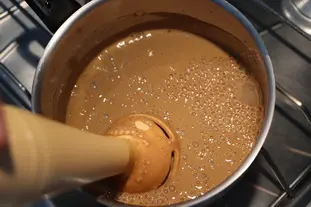The gelling agent in a cream

If you start making a Bavarian cream for example, or any other that contains a gelling agent such as gelatin or agar-agar, you will sooner or later be confronted with the problem: How to properly incorporate this gelling agent into my cream? (and we will focus on gelatin)
12 K 4.9/5 (19 reviews)
Keywords for this post:Gelling agentIncorporationDispersionCreamGelatinBlenderLast modified on: June 18th 2022
The gelling agent in a cream
"Well" means regularly, evenly, so that the consistency of the cream is well homogeneous, and it is not so easy as that.
Well it is often the case in fact, we heat a first mixture for a cooking (like custard) and then we incorporate the gelatin, but it is necessary to remember it anyway.
Then it's a question of structure, the gelatin is in a different form from your cream, which is rather liquid.
The gelatin is either sheets (of 2 gr) or powder, and incorporating it into the structure of your future cream involves some precautions.
If you use powdered gelatin, it's easier: you pour the powder directly into your hot cream, whisking at the same time to disperse immediately.
In practice, you may have some concerns about the homogeneity of your cream, with some areas a little more set than others, especially if your cream was a little low in temperature (< 50°C).
Not only will you disperse the gelatin perfectly, but you will also smooth your cream, which will be even smoother once it has cooled.
This dispersal of gelatin, and of gelifiers in general, in a mixer is a common practice among professional pastry chefs.
Don't hesitate to use this professional trick to obtain very nice and creamy creams at home.
To sum up: To properly incorporate a gelling agent into a cream, you must make it "hot cream" and then disperse it with a mixer for a homogeneous result.
What is the problem?
First of all, it's a question of temperature: gelatin is soluble at 37°C, so it is imperative that your cream is above that temperature, otherwise it will not dissolve.Well it is often the case in fact, we heat a first mixture for a cooking (like custard) and then we incorporate the gelatin, but it is necessary to remember it anyway.
Then it's a question of structure, the gelatin is in a different form from your cream, which is rather liquid.
The gelatin is either sheets (of 2 gr) or powder, and incorporating it into the structure of your future cream involves some precautions.
Sheets and powder
If you use gelatin sheets, you will first have to soften them for 5 minutes in a bowl of cold water, then wring them out (squeeze them in your hand over the sink), pour them into your hot cream and immediately mix them well, we say "disperse", with a whisk for example or with a maryse.
If you use powdered gelatin, it's easier: you pour the powder directly into your hot cream, whisking at the same time to disperse immediately.
Is this enough?
In theory yes, if you did it quickly and well, no problem for your cream.In practice, you may have some concerns about the homogeneity of your cream, with some areas a little more set than others, especially if your cream was a little low in temperature (< 50°C).
Is there a way to ensure a perfect dispersion?
Yes, just give your cream a quick blast with a mixer (less than 10 seconds) once the gelatin is incorporated.Not only will you disperse the gelatin perfectly, but you will also smooth your cream, which will be even smoother once it has cooled.

This dispersal of gelatin, and of gelifiers in general, in a mixer is a common practice among professional pastry chefs.
Don't hesitate to use this professional trick to obtain very nice and creamy creams at home.
To sum up: To properly incorporate a gelling agent into a cream, you must make it "hot cream" and then disperse it with a mixer for a homogeneous result.
Lasts posts
Cake moulds
When we make a cake, or a cake of the same rectangular shape, we usually take out our usual mould and tell ourselves that the recipe is anyway "for a cake", but is it really that simple?August 25th 20256545
Thinning out herbs
If you need to add a long-stemmed herb (tarragon, mint, verbena, thyme, etc.) to a recipe, you'll probably only need the leaves and not the stem, so you'll need to remove the leaves. Leaf removal means keeping only the beautiful leaves, and eliminating the ugly stems and leaves, but how do you do...August 8th 20251,1775
Add a bay leaf
Bay leaf: small in size, but big in flavor. You'll find it in hundreds of recipes, and it's often added to cooking meat, in a sauce or broth, usually accompanied by other herbs or products. It's a staple of Provençal, Mediterranean and Oriental cuisine, but not the only one. Usually, in a...July 31th 20251,2685
Parsley stems
Parsley, whether curly or flat, is a delicious ingredient in many recipes, where it is used both raw and cooked. When used raw, in a salad for example, where it always provides, alone or with other herbs, a remarkable freshness, only the leaves are kept. And when used cooked?July 28th 20251,354 13
A drizzle of olive oil
Often in a recipe, you have to "baste" vegetables, for example, before sending them to the oven. What the author means by this is that you need to put oil on top of the vegetables to cook them in the oven. Typically, we just quickly drizzle oil over the vegetables, hoping not to miss any, but...July 13th 20251,5485
Other pages you may also like
Thinning out herbs
If you need to add a long-stemmed herb (tarragon, mint, verbena, thyme, etc.) to a recipe, you'll probably only need the leaves and not the stem, so you'll need to remove the leaves. Leaf removal means keeping only the beautiful leaves, and eliminating the ugly stems and leaves, but how do you do...August 8th 20251,1775
Let's rehabilitate spinach
We are currently (as I write this) in the season of fresh spinach, and it is a delicious vegetable that unfortunately has a bad reputation among a lot of people, children and teenagers in particular. I wonder if this lack of appetite isn't due to what I call, probably unfairly, "school food...May 7th 20215,8874.8
Egg whites management
Quite often, in cooking or pastry-making, we have recipes that use only egg yolks: gâteau breton (brittany butter cake), confectioner's custard, spaghetti carbonara, etc. And so, inevitably, we end up with unused egg whites that will have to be used elsewhere, in another recipe, and certainly...June 12th 20219,0364.9
A few tips for effective kneading at home
When you have to knead dough for bread or some other recipe, you may well use a food processor or the type of machine known as a stand mixer. The best-known brands are Kenwood and KitchenAid. They are useful tools, but here are a few tips to help you get the best out of them.June 23th 2021277 K 23.7
Egg yolks and caster sugar
We often come across recipes where we need to mix egg yolks with caster sugar. This would appear to be a very ordinary and simple thing to do but, be warned, these two ingredients can behave oddly together.February 15th 201879 K 24.3
Post a comment or question
Follow this page (as 2 people already do)
If you are interested in this page, you can "follow" it, by entering your email address here. You will then receive a notification immediately each time the page is modified or a new comment is added. Please note that you will need to confirm this following.
Note: We'll never share your e-mail address with anyone else.
Alternatively: you can subscribe to the mailing list of cooling-ez.com , you will receive a e-mail for each new recipe published on the site.








